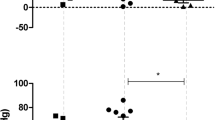Summary
Electrical activity in a renal nerve, blood pressure, and respiration were recorded in dibenzylinized rats and responses were observed to direct electrical stimulation of the medulla oblongata with the object of localizing and identifying those structures which on stimulation produce inhibition of sympathetic discharge.
Inhibition of discharge in the renal nerve can be obtained from two well defined areas. One of them (here termed area A) corresponds to the Nucleus and Tractus solitarius. The other area (area B in this communication) occupies the general region of the medial longitudinal fasciculus and the medial tecto-spinal tract at the level of the rostral part of the hypoglossal nucleus. Inhibitory responses from these two areas differ in certain characteristics and those obtained from area A are not abolished by destruction of area B. This supports the conclusion that the two areas are functionally as well as topographically separate.
Zusammenfassung
Bei mit Dibenzylin vorbehandelten Ratten wurde der Einfluß direkter elektrischer Reizung der Medulla oblongata auf Blutdruck, Atmung und elektrische Aktivität in einem Nierenast des Sympathicus registriert, mit dem Ziele, jene bulbären Strukturen zu lokalisieren, deren Reizung Sympathicushemmung verursacht.
Hemmung der Entladungen des Nierensympathicus kann von zwei gut umschriebenen Arealen der Medulla ausgelöst werden. Das eine (hier genannt Area A) entspricht dem Gebiete des Nucleus und Tractus solitarius. Das andere Gebiet (Area B dieser Mitteilung) befindet sich im Felde des Fasciculus longitudinalis medialis und des Tractus tectospinalis medialis in Höhe des rostralen Drittels des Nucleus n. hypoglossi. Die Sympathicushemmungen, welche von den beiden Gebieten ausgelöst werden können, unterscheiden sich in gewissen Merkmalen und jene, welche durch Reizung der Area A verursacht werden, bleiben nach lokalisierter Koagulation von Area B weiterhin auslösbar. Es wird gefolgert, daß die beiden Gebiete nicht nur topographisch, sondern auch funktionell zu unterscheiden sind.
Résumé
Chez des rat traités à la di-benzyline, l'activité électrique d'une branche du sympathique rénal, la pression artérielle et la respiration au cours d'une stimulation directe de la moelle prolongée ont été enregistrées dans l'intention de localiser et d'identifier les formations bulbaires dont la stimulation produit une inhibition sympathique.
On peut obtenir une inhibition des décharges dans le sympathique rénal à partir de deux aires bien définies de la moelle prolongée, l'une (aire A) correspond au noyau et au faisceau solitaire, l'autre (aire B) occupe la région du faisceau longitudinal médian et du tractus tecto-spinal médian au niveau de la partie rostrale du noyau de l'hypophyse. Les inhibitions des deux aires diffèrent entre elles et celles obtenues à partir de l'aire A ne sont pas abolies par la destruction de l'aire B. Ceci est en faveur de l'idée que ces deux aires sont indépendantes tant au point de vue topographique que fonctionnel.
Similar content being viewed by others
References
Alexander, R. S., J. Neurophysiol., Springfield,9 (1946), 205–217.
Allen, W. F., J. Comp. Neurol., Philadelphia,42 (1927), 393–456.
Amoroso, E. C., F. R. Bell, andH. Rosenberg, J. Physiol.126 (1954), 86–95.
Ariëns Kappers, C. U., G. C. Huber, andE. C. Crosby, The comparative anatomy of the nervous system of vertebrates, including man. p. 1074, Hafner, New York, 1960.
Bach, L. M. N., Amer. J. Physiol.171 (1952), 417–435.
Crosby, E. G., T. Humphrey, andE. W. Lauer, Correlative anatomy of the nerous system. McMillan, New York, 1962.
Dejerine, J., Anatomie des centres nerveux. Reuff, Paris, 1901. Quoted fromCrosby, Humphrey andLauer, l. c., p. 592.
Gernandt, B., G. Liljestrand, andY. Zottermann, Acta physiol. Scand.11 (1946), 230–247.
Gutman, J., Y. Ginath, M. Chaimovitz, andF. Bergmann, Arch. internat. physiol. biochem.70 (1962), 583–598.
Kabat, H., H. W. Magoun, andS. W. Ranson, Arch. Neurol.34 (1935), 931–955.
Kehrel, H., N. Mutharoglu, andH. Weidinger, Zschr. Kreisl.forsch.51 (1962), 334–351.
Kosaka, K., andK. Yagita, Shimkeigaku Zasshi Tokyo, Bd. 4, S. 29. Quoted fromAriëns Kappers, C. U., and coll., l. c. The comparative anatomy of the nervous, system of vertebrates, including man. p. 373, Hafner, New York, 1960.
Lindgren, P., andB. Uvnaes, Acta physiol. Scand.29 (1953), 137–144.
Lindgren, P., andB. Uvnaes, Amer. J. Physiol.176 (1954), 68–76.
Miller R. F., andJ. T. Bowman, Amer. J. Physiol.39 (1916), 149–153.
Monnier, M., Rev. neurol., Paris,70 (1938), 521–527.
Oberholzer, R. J. H., Helvet. physiol. pharmacol. acta13 (1955), 331–353.
Papez, J. W., J. Comp. Neurol., Philadelphia,41 (1926), 365–399.
Ranson, S. W., andP. R. Billingsley, Amer. J. Physiol.41 (1916), 85–90.
Scherrer, H., Acta neuroveget., Wien,23 (1962a), 499–522.
Scherrer, H., Ann. N. Y. Acad. Sc.98 (1962b), 1302–1314.
Scherrer, H., Exper. Neurol.7 (1963), 343–354.
Scherrer, H., Acta neuroveget., Wien,29 (1966), 45–55.
Scott, J. M. D., andF. Roberts, J. Physiol.58 (1923/24), 168–174.
Sell, R., A. Erdelyi, andH. Schaefer, Arch. Physiol., Bonn,267 (1958), 566–581.
Wang, S. C., andS. W. Ranson, J. Comp. Neurol., Philadelphia,71 (1939), 437–455.
Weidinger, H., L. Fedina, H. Kehrel, andH. Schaefer, Zschr. Kreisl.forsch.50 (1961), 229–241.
Wilkus, R. J., andC. N. Peiss, Amer. J. Physiol.205 (1963), 601–605.
Author information
Authors and Affiliations
Additional information
With 9 Figures
This study was supported by grants from the Medical Research Council of Canada and from the British Columbia Heart Foundation.
Rights and permissions
About this article
Cite this article
Scherrer, H. Inhibition of sympathetic discharge by stimulation of the medulla oblongata in the rat. Acta Neurovegetativa 29, 56–74 (1966). https://doi.org/10.1007/BF01226707
Received:
Issue Date:
DOI: https://doi.org/10.1007/BF01226707




